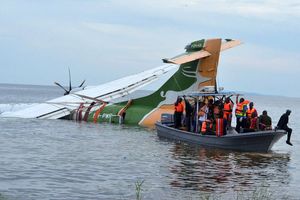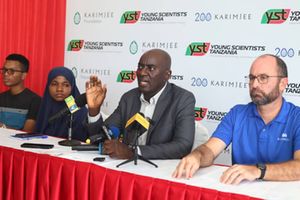Tanzania-Rwanda: How to be good friends, again

Forever good neighbours? When Presidents John Magufuli was sworn into office in November 2015, he had a great opportunity to rebuild bridges, and since his inauguration, relations have notably warmed. PHOTO I FILE
What you need to know:
That President Magufuli visited Rwanda in his first official trip abroad in April this year and President Kagame has – within a space of just three months – made effort to reciprocate the visit points to a turning point in the recent history of Tanzania and Rwanda, two of the five member countries of the East African Community (EAC).
Dar es Salaam. With Tanzanian President John Magufuli having hosted his Rwandan counterpart, President Paul Kagame, on a recent two-day state visit that began on July 1, it’s now time for the two countries to inject useful supplementary ingredients into their good neighbourliness, friendship and cooperation.
After the frosty diplomatic relations that seemed to go downhill during the Kikwete administration, Tanzania and Rwanda are walking out of the woods.
That President Magufuli visited Rwanda in his first official trip abroad in April this year and President Kagame has – within a space of just three months – made effort to reciprocate the visit points to a turning point in the recent history of Tanzania and Rwanda, two of the five member countries of the East African Community (EAC).
By President Magufuli publicly extending his thanks to President Kagame at a joint press conference in Dar es Salaam for advice offered on how Tanzania could, for example, acquire good planes for its national carrier Air Tanzania in a brief period of time, the two leaders sent a clear signal that, Tanzanians and Rwandans were opening a “new chapter” in diplomatic relations, bilateral trade and economic cooperation, espousing the wider cause of reinforcing the EAC, whose current chair is President Magufuli.
During his two-day visit, President Kagame officially inaugurated the 40th Dar es Salaam International Trade Fair (DITF), held annually at the Saba Saba grounds in Dar es Salaam. Besides this, the Rwandan president also charted with his host, President Magufuli, the future direction of bilateral cooperation.
The visit, symbolic of the tactical shrewdness of both Dodoma and Kigali, is assuredly set to imbue the strategic diplomatic and trade relations between the two capitals with more robustness and trust.
Prior to the joint press conference, the two sides, represented by their Foreign Affairs ministers, Augustine Mahiga for Tanzania and Louise Mushikiwabo for Rwanda, also signed the minutes of a Joint Permanent Commission meeting held in Rwanda on April 1 this year, covering such areas as infrastructure, trade, investment and human resources.
In today’s geopolitical environment, the strategy behind the renewed relations is not difficult to spot.
At the press conference, President Magufuli noted that Rwanda is very competent in Information and Communication Technology (ICT) and revealed that, in a bid to set establish a “robust and tamper-proof revenue collection system”, President Kagame will avail ICT experts to Tanzania.
President Magufuli also revealed that his government has apportioned $460 million (Sh1 trillion) as part of funds towards the Dar es Salaam-Isaka/Kigali/Keza-Musongati (DIKKM) standard gauge railway line, whose construction, he added, would start concurrently in Tanzania and Rwanda so as to expedite its completion by March 2018.
Since Dar es Salaam has the most proximate route to the Indian Ocean for Rwanda’s exports and imports, this is a welcome development and sensible way forward for land-locked Rwanda. The DIKKM standard gauge railway (SGR) line, estimated to cost $5.2 billion, is expected to enlist additional funding from development partners, including Xi Jinping’s China.
Fortified relations with Rwanda are similarly imperative for President Magufuli’s vision of a transformative Tanzania, and here’s why (Hint: natural gas). Following the 57-trillion cubic feet of offshore natural gas discovery and the newly-found helium gas field, Tanzania also needs to secure its future gas market from Rwanda and other countries.
Hence, the SGR line could help Tanzania distribute its downstream finished gas products to those countries. In today’s geopolitical environment, the strategy behind the renewed relations is not difficult to spot.
It should be noted that the “proximate card” also came into play when Uganda had to select between Kenya and Tanzania on the route the $4 billion crude oil pipeline from Uganda’s Lake Albert Basin should take.
While Uganda and Kenya had a standing arrangement that the pipeline would pass via Kenya, Uganda picked on the Tanzanian route through which pipeline will deliver potentially-lucrative crude oil to export markets via the port of Tanga along the Indian Ocean. This gave President Magufuli political and diplomatic influence within the EAC region, and confirms – especially in diplomatic matters – that size is not always equal to influence. In its re-invigorated engagement with Rwanda and Uganda, however, the Magufuli administration is not ardent to break Dar es Salaam’s key relations with Kenya and other EAC countries.
As chair of the EAC, Tanzania is keen to maintain superb relations in the context of good neighourliness, friendship and cooperation with all its EAC-member countries like it has just done with Rwanda. In respect of South Sudan, for instance, Tanzania has provided training and capacity building to the ministry of finance, particularly on fiscal policy and taxation.
President Kagame’s tight but, nevertheless, encouraging two-day official visit mirrored the optimism that swelled with the Tanzania-Rwanda bilateral ties recently. As the past frosty diplomatic relations saw analysts worry over the EAC bloc, the development bears testimony to the two EAC countries’ flair and determination to appropriately deal with their differences.
Indeed, with the shifting diplomatic landscape and with President Magufuli steering the wheel of diplomacy in Tanzania, the EAC bloc can expect to take advantage of the camaraderie between the leaders.
As President Kagame said during his visit, Rwanda, which President Magufuli described as “our good neighbour," “will continue to work closely with the government of Tanzania by creating business opportunities to benefit the people of both countries”.
Meanwhile, Tanzania is sparing no efforts to facilitate smooth trade by allocating space for an inland container depot (ICD) to specially cater for the 75 per cent of Rwanda’s cargo that passes through the port of Dar es Salaam, and the two sides have also jointly agreed to open a Tanzania Ports Authority (TPA) office in Rwanda to facilitate cargo document processing there without bothering Rwandan importers and exporters to travel all the way to Dar es Salaam.
Taken together with the removal of roadblocks to reduce non-tariff barriers, such endeavours will heighten bilateral trade and economic cooperation and deliver tangible and visible benefits to the two countries.
Consequently, Tanzania and Rwanda should grab the opportunities presented by the bilateral cooperation and, by giving full play to their presidents’ straightforwardness, results-and-anti-corruption-driven stance and diplomatic astuteness, enhance the values of mutual understanding, trust, benefit and win-win results.
In that way, the two countries, linked still further by their common membership in the EAC, will fruitfully tackle any and all unsettled problems and challenges in their cooperation.
Taking lessons from the past and looking into the future, today Tanzania and Rwanda exult in their recharged diplomatic relations, trade and economic ties, viewed by analysts as being critical to stability in the East African region. Shouldn’t their case be an example for other countries the world over to follow?
The author is an Advocate of the High Court of Tanzania and the Managing Partner of a Tanzanian law firm Kibuuka Law Chambers. Email: [email protected] Twitter: @kibuukalaw.com




